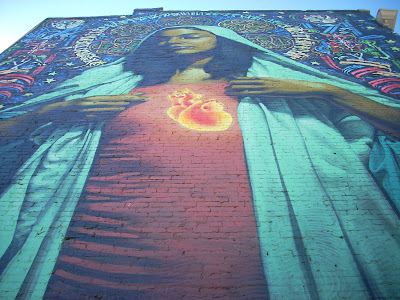Sunday Afternoon: Griffith Park Drum Circle
by Armando Ortiz
Two Sundays ago I hiked up to Mt Hollywood and then descended down the Northeast side to where the Merry-Go-Round and the weekend drum circle are located. I figured it would be a nice place to relax a bit, read a few pages of Joyce’s Ulysses of which I'm almost done, and listen to some live music. I went down the trail slowly making my way to the drum circle. I made my final approach and sat under a tree a few meters away from the circle. I sat on the grass and lounged for a bit under the shade of an oak tree.
I saw people and all kinds of hands slapping drums, congas, djembes, bongos and tambourines or holding sticks that were either striking something or rasping some kind of instrument. Kids were running around, and toddlers dancing to the groove, along with their parents who were enjoying the music. There were ladies who wore speckles on their hips that made shingly sounds. Their hips swayed, rocked, twisted and shot from side to side rhythmically making their speckles shiver under the sun’s heat. The beats that emanated from the circle reminded me that people have been coming here and doing this for decades. The spirit of those that started this circle years ago resonated with childhood memories of when my family would go come to this part of Griffith Park for weekend barbecues. My siblings and I would play in the jungle gyms, use the swings, and slide down the shimmering slides. Occasionally we’d go ride the Merry-Go-Round that would go round and round as the plaster cast horses that were painted in bright pastels moved up and down. Even as we got older and sandboxes were replaced with baseballs, soccer balls, and footballs, we could still hear the rhythmic beats that were being born from that corner of the park.
As I sat down to hear the beats, a whirlpool of memories were brought up in that instant, like a sudden cloud funnel that appears out of nowhere and then disappears in the present nothingness of the sky. At that moment I got the idea to write about this spot, which lies hidden to many people who call Los Angeles home.
It surprises me that this spot is always very intimate and the people that come here are relaxed and are either making percussion beats or enjoying the sounds being made with the hands of a group of people that come from various and differing backgrounds. Some folks instead of drums bring grills to cook meat so as to have some live music in the background. The shade that the old oaks and pine trees make is something special. Griffith Park is in Los Angeles, and it is only a few minutes away from the I-5, and only ten to fifteen minutes from Downtown L.A.
In between the silhouette of the trees I could see weekend warriors riding their shinny two wheelers glide bye, SUVs filled to the brim with working class families trudging through, and late-model Hondas zooming by, and all of them, no matter who was in them slowed down a bit and momentarily enjoyed the sounds that emanated from the shade. Some made a U turn and parked their cars, while others clapped or cheered, and others just kept driving.
I can remember many times looking out the window as I scanned the area and wondered who those people were. I usually thought they were hippies having a drum fest, but as time went on I came to realize that it’s a group of people committed to bringing music to the park, and what fortune do we have that it’s at Griffith Park and not some far away location. Not only are they bringing music, but through them one connects to that grander beat that pumps through all the people that call this place home. The sounds truly represent the varied experiences that all have in this city and around the world, and in a way connects us to that time when we first heard the simple, but complex beats of a drum.
Listening to all the performers I was reminded of a Grateful Dead song “Playing in the Band.” The song talks about people of all walks of life that have existed, exist, and will exist. Yet the message of the song is that all of us in some way add our bit of beat to this life, our soul merges with the souls of all others and we make a chaotic choir and harmonic big band that extends wide out and up to outer space. Of course I’m going overboard, but it’s nice to know that on a nice Sunday afternoon we can go to the park and enjoy some of the music that our long past ancestors enjoyed on beautiful days like this past Sunday.
